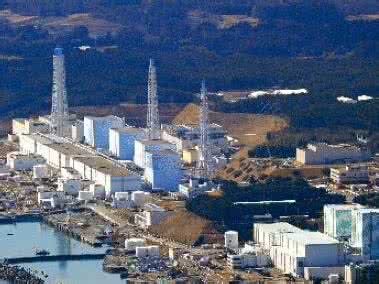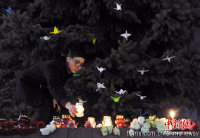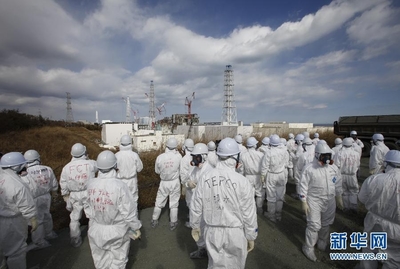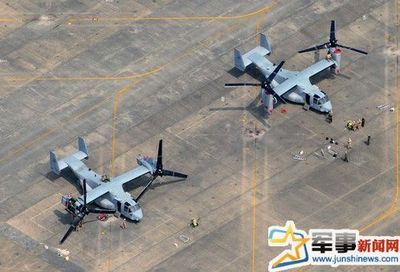Two years since a shudder in the Earth's crust devastated Japan, the country's scientists and engineers are still attempting to develop technologies to make Fukushima safe from radiation. But progress has been slow and—because of institutional failings—more advanced technologies have not been available to workers at the sire.
日本遭受大地震重创之后已经过去了两年时间,该国的科学家和工程师仍然在尝试研发发更先进的技术,以保护福岛免受辐射侵害。不过由于研发进展缓慢,而且制度存在缺陷,当地的工人仍然无法采用更先进的技术。
A country known as a technological superpower ultimately had to rely on low-tech methods during the disaster, including dumping water from the air to cool the raging reactors. High radiation levels prevented engineers from approaching critically damaged areas at the plant two years ago—and still does so today. Robots that some expected to be on call were conspicuously absent. The country faces a bill of between $1 billion and $2.5 billion dollars to dismantle the Fukushima plant, and 40 years until it is safely decommissioned.
日本虽以超级科技大国著称,但在这次灾难中为了冷却核反应堆温度,最终只能依靠空中泼水这类低技术含量的办法。两年前,强辐射让工程师无法进入核电站的关键损毁区域——今天依然如此。本以为能随时待命的机器人明显缺席了。日本需要花费10到25亿美元拆除福岛核电站,而要让它安全退役,还得花上40年。
Only now are robots being developed that might be able to access the most contaminated areas within the shattered reactors' cores. So how did Japan, with the worlds' most "advanced" robots (not to mention the biggest population of them), fail to deploy the machines that might have spared dangerous human toil?
如今,有可能抵达位于反应堆核心的污染重灾区的,只有尚处于研发阶段的机器人。那么,拥有世界最先进机器人(更不用说机器人数量最多)的日本为何之前没能配置机器人,让工人免于从事如此危险的工作呢?
"For a start," says Dr. Masashi Goto who worked on designing containment vessels of Mark-1 reactors like those at Fukushima Daiichi, "neither Japan's nuclear power industry nor the government concede that an accident like this could ever happen. They have long held that all of Japan reactors are 'absolutely safe.'" In other words, why prepare emergency backups or robots for the event of a quake-induced meltdown when the authorities denied such a thing could ever happen? Doing so would acknowledge a danger perpetually denied.
后藤政志博士曾参与设计了福岛第一核电站1号反应堆密闭壳。他说:“最初,日本核能工业和政府都不认为会发生这样的事故。他们长期以来的观点是,日本所有的反应堆都‘绝对安全’。换句话说,当局认为,地震根本不会导致反应堆熔毁,有必要事先准备紧急预案或者机器人吗?那样做就等于承认危险确实存在,而他们一直否认有任何危险。”
"They said that accidents owing to earthquakes would be minimal," adds Goto. "As a consequence the companies involved in designed these reactors were told only to make 'voluntary efforts to make the reactors' containment vessel quake proof."
后藤说:“他们称地震导致事故的可能性几乎为零。因此,参与设计核反应堆的公司被告知,并不强制要求该公司为核反应堆密闭壳做抗震处理,但可以自愿无偿进行。”
Although TEPCO the firm that built and ran the reactors, and the authorities knew disaster response technology on hand was old, little was done to provide backups, such as robots, in the event of a meltdown. Cheap nuclear power was—and still is—too important to Japan's economic competitiveness.
尽管建造和运营反应堆的东京电力公司(TEPCO)和政府当局都知道现有的灾后应急技术陈旧过时,却在准备熔毁事故应急方案(例如机器人救援)时几乎无所作为。不论过去还是现在,廉价的核能对日本经济竞争力实在是太过重要了。
Luckily, so far radiation released from Fukushima is only one tenth of Chernobyl's. The Ukrainian plant blew its top, literally, and spewed, chimney like, nuclear fallout far and wide. Daiichi shutdown, Chernobyl did not. Enough safety protocols functioned to avert an even larger disaster, but the reactors remain unstable. Still, the fact is that no machine exists that can safely obtain proper readings from near the radioactive cores. "It will be difficult to explain where the fuel is. We can't get close enough for proper measurements," admits Yoshinori Moriyama, of Japan's nuclear watchdog NISA.
幸运的是,到目前为止,福岛泄露的核辐射仅有切尔诺贝利核电站泄漏事故的十分之一。当年,那所乌克兰核电站的屋顶被掀翻,如烟囱一般将核微粒喷洒向四面八方。福岛核电站被关闭,切尔诺贝利核电站却没有。全面的安全协议发挥了作用,避免了更大的灾难,但是目前反应堆仍然不稳定。然而问题是,现在的机器仍然无法从附近的反应堆堆芯中安全地获取正确的数据。日本核能监察机构原子力安全保安院(NISA)的嘉点森山承认:“很难搞清楚燃料究竟在哪。我们无法靠近,开展测量工作。”
At the centre of all this are the Daiichi workers—those unlucky enough to have the task, limited to a few moments at a time, of labouring inside the debris-strewn reactor buildings. With radiation high enough to sabotage electronics, American robots donated to the Daiichi plant have been missing in action, along with a Japanese robot dubbed Quince. Human labor for some of the most dangerous tasks has had to substitute.
福岛核电站的工人则处在事件最中心——这些不走运的人承担了这项任务,每次只能在这些洒满残骸的核反应堆建筑中工作很短的时间。辐射强到可以干扰电子设备,所有捐赠给福岛核电站的美国机器人都在任务中失去了联系,一同失踪的还有一台名为“Quince”的日本机器人。因此,某些最危险的任务还是只能通过人力来完成。

 爱华网
爱华网


